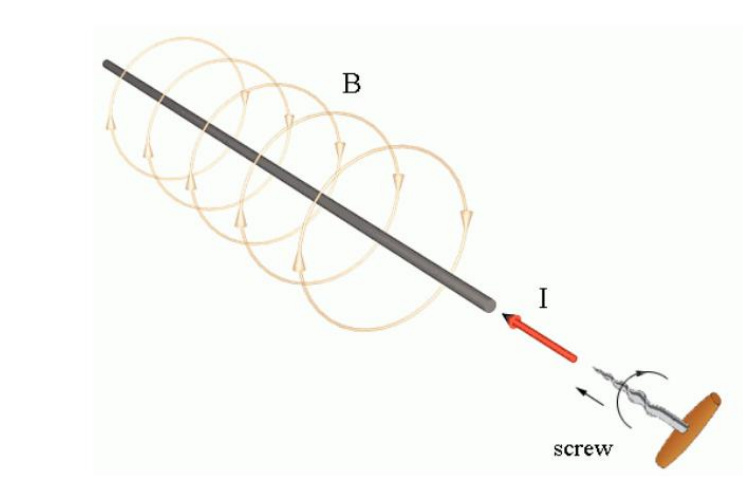
Outline of the Article:
- Introduction
- Overview of Maxwell’s Screw Rule
- Importance in electromagnetism
- Understanding Maxwell’s Screw Rule
- Definition of the rule
- Relation to electromagnetism
- Concept of Right-Handed Screw Motion
- Explanation with a screw analogy
- How it applies to current and magnetic field
- Mathematical Representation
- Formula and vector notation
- Connection to the Right-Hand Rule
- Application in Electromagnetic Induction
- Use in solenoids and coils
- Magnetic field direction in a current-carrying conductor
- Difference Between Maxwell’s Screw Rule and Right-Hand Rule
- Key distinctions
- When to use each rule
- Practical Examples
- Daily life applications
- Industrial and technological uses
- Diagram and Visual Representation
- Importance of images in understanding
- Suggested illustrations (e.g., screw analogy, magnetic field direction)
- Conclusion
- Summary of key points
- Final thoughts on its significance
- FAQs
- What is Maxwell’s Screw Rule used for?
- How does it differ from Fleming’s rules?
- Can Maxwell’s Screw Rule be applied to electric fields?
- What are common misconceptions?
- Where is this rule used in real-world applications?
Article: Maxwell’s Screw Rule – A Fundamental Concept in Electromagnetism
Introduction
In the world of electromagnetism, understanding the relationship between electric current and magnetic fields is crucial. One of the key principles used to determine the direction of the magnetic field around a current-carrying conductor is Maxwell’s Screw Rule. This simple yet powerful rule provides a fundamental way to visualize and predict the behavior of electromagnetic fields.
Understanding Maxwell’s Screw Rule
Maxwell’s Screw Rule states that if a right-handed screw is turned in the direction of the conventional current, then the direction of rotation of the screw gives the direction of the magnetic field. This rule is an essential tool in physics, helping engineers and scientists determine the orientation of magnetic fields created by electric currents.
Concept of Right-Handed Screw Motion
To understand this rule better, imagine turning a screw into a wooden surface:
- The linear movement of the screw represents the direction of the electric current.
- The rotational movement of the screw head represents the direction of the magnetic field lines.
This analogy makes it easy to remember how magnetic fields wrap around a conductor. The screw moves forward in the same direction as the current, and its rotation gives the circular path of the magnetic field.
Mathematical Representation
Mathematically, the relationship between current (II) and the magnetic field (BB) is given by Ampere’s Law: ∮B⋅dl=μ0I\oint B \cdot dl = \mu_0 I
Where:
- BB is the magnetic field,
- dldl is the infinitesimal length along the closed loop,
- μ0\mu_0 is the permeability of free space,
- II is the enclosed current.
This equation supports Maxwell’s Screw Rule by explaining how the field circulates around a current-carrying wire.
Application in Electromagnetic Induction
Maxwell’s Screw Rule is widely used in:
- Determining the Magnetic Field Around a Straight Conductor
- If current flows upwards in a vertical wire, the magnetic field circles counterclockwise when viewed from above.
- Finding the Magnetic Field in a Solenoid
- In solenoids, applying Maxwell’s Screw Rule helps establish that the magnetic field inside the coil is uniform and directed along the axis.
Difference Between Maxwell’s Screw Rule and Right-Hand Rule
Although Maxwell’s Screw Rule and the Right-Hand Rule serve similar purposes, they differ in approach:
| Aspect | Maxwell’s Screw Rule | Right-Hand Rule |
|---|---|---|
| Analogy Used | Screw rotation | Fingers & thumb |
| Focuses On | Relationship between current and field direction | Predicting force on a charged particle |
| When to Use | When analyzing a straight current-carrying conductor | When dealing with magnetic force in electric motors |
Practical Examples
Maxwell’s Screw Rule is applied in:
- Electrical engineering – Understanding transformer coils.
- Physics experiments – Analyzing magnetic fields in wires.
- Technology – Used in designing electromagnets and solenoids.
Diagram and Visual Representation
To better grasp this concept, it is helpful to visualize a right-handed screw with arrows indicating the current direction and magnetic field. Including such images in textbooks or tutorials enhances comprehension.
Conclusion
Maxwell’s Screw Rule is a simple yet essential principle in electromagnetism. By relating electric current to magnetic fields using a screw analogy, this rule helps in understanding fundamental concepts in electrical and electronic engineering. Mastering this rule provides a strong foundation for studying electromagnetic forces and applications.
FAQs
1. What is Maxwell’s Screw Rule used for?
Maxwell’s Screw Rule is used to determine the direction of the magnetic field around a current-carrying conductor.
2. How does it differ from Fleming’s rules?
Fleming’s Left-Hand and Right-Hand Rules focus on force direction in motors and generators, whereas Maxwell’s Screw Rule explains the magnetic field around a wire.
3. Can Maxwell’s Screw Rule be applied to electric fields?
No, it specifically applies to the relationship between electric current and magnetic fields.
4. What are common misconceptions?
Some confuse it with Fleming’s rules or think it applies to forces rather than fields.
5. Where is this rule used in real-world applications?
It is used in designing electrical circuits, electromagnets, solenoids, and transformers.
